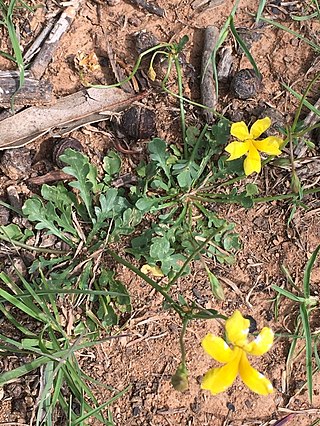
Banksia ornata, commonly known as desert banksia, is a species of shrub that is endemic to south-eastern continental Australia. The Ngarrindjeri people of the Lower Murray region in South Australia know it as yelakut. It has thin bark, serrated, narrow egg-shaped leaves with the lower end towards the base, cream-coloured flowers in a cylindrical spike, and later, up to fifty follicles in each spike, surrounded by the remains of the flowers.

Acacia glaucoptera, commonly known as flat wattle or clay wattle, is a species of Acacia which is endemic to the south-west of Western Australia.

Diuris behrii, commonly known as golden cowslips, is a species of orchid which is endemic to southern continental Australia. It has between three and six grass-like leaves and a flowering stem with up to four drooping, yellow flowers with dark streaks on the labellum. The flowers appear between September and November in its native range.

Grevillea micrantha, also known as small-flower grevillea, is a species of flowering plant in the family Proteaceae and is endemic to Victoria in Australia. It is a spreading shrub with linear leaves and clusters of white to pale pink flowers.

Leptospermum myrsinoides, commonly known as the heath tea-tree or silky tea-tree, is a species of shrub that is endemic to south-eastern continental Australia. It has smooth bark on the younger stems, narrow egg-shaped leaves with the narrower end towards the base, white flowers and fruit that has the remains of the sepals attached but usually falls from the plant soon after the seeds are released.

Billardiera sericophora is a species of flowering plant in the family Pittosporaceae and is endemic to the south-east of South Australia. It is spreading shrub or climber that has mostly narrowly elliptic leaves and pendent yellow flowers arranged singly or in pairs.

Acacia bynoeana, known colloquially as Bynoe's wattle or tiny wattle, is a species of Acacia native to eastern Australia. It is listed as endangered in New South Wales and as vulnerable according to the Environment Protection and Biodiversity Conservation Act 1999.

Caladenia tentaculata, commonly known as the eastern mantis orchid, large green-comb, green comb or fringed spider orchid is a plant in the orchid family Orchidaceae and is endemic to south-eastern Australia. It is a ground orchid with a single, hairy leaf and up to three green flowers with red stripes on the sepals and petals.

Hakea rostrata, common name beaked hakea, is a flowering plant in the family Proteaceae, native to South Australia and Victoria.

Goodenia calcarata, commonly known as streaked goodenia, is a species of flowering plant in the family Goodeniaceae and is endemic to Australia. It is an erect, annual herb with toothed egg-shaped to oblong leaves, racemes of white, cream-coloured or pink to mauve flowers with brownish markings, and oval fruit.

Goodenia pinnatifida, commonly known as cut-leaf goodenia, scrambled eggs or mother ducks, is a species of flowering plant in the family Goodeniaceae and endemic to Australia. It is a low-lying to ascending perennial herb with toothed to pinnatisect leaves, racemes of yellow flowers and more or less spherical fruit.

Dampiera rosmarinifolia, commonly known as rosemary dampiera, is a flowering plant in the family Goodeniaceae.It is a perennial subshrub with linear leaves, mauve or purple flowers borne in leaf axils.

Spyridium coactilifolium, commonly known as butterfly spyridium, is a species of flowering plant in the family Rhamnaceae. It has white-velvety flowers and oval shaped leaves that are thickly covered in soft hairs.

Olearia muelleri, commonly known as Mueller daisy bush, Mueller's daisy bush or Goldfields daisy, is a species of flowering plant in the family Asteraceae and is endemic to southern continental Australia. It is a compact or spreading shrub with scattered spatula-shaped to egg-shaped leaves with the narrower end towards the base, and white and yellow, daisy-like inflorescences.
Pomaderris flabellaris, commonly known as fan pomaderris, is a species of flowering plant in the family Rhamnaceae and is endemic to South Australia. It is a low shrub with fan-shaped leaves, and small clusters of woolly-hairy flowers.

Pomaderris helianthemifolia is a species of flowering plant in the family Rhamnaceae and is endemic to south-eastern continental Australia. It is a bushy shrub with hairy young stems, narrowly elliptic to lance-shaped leaves with the narrower end towards the base, and small panicles of hairy yellowish flowers.

Olearia brachyphylla is a species of flowering plant in the family Asteraceae and is endemic to southern continental Australia. It is a densely-branched, aromatic shrub with woolly-hairy stems, oblong to egg-shaped leaves with the narrower end towards the base and small white and pale yellow, daisy-like inflorescences.
Olearia hookeri, commonly known as crimsontip daisybush, is a species of flowering plant in the family Asteraceae and is endemic to Tasmania. It is a sticky shrub with small, narrowly linear leaves and white to bluish-purple and yellow, daisy-like inflorescences.
Pimelea micrantha, commonly known as silky rice-flower is a species of flowering plant in the family Thymelaeaceae and is endemic to southern Australia. It is a much-branched undershrub with narrowly elliptic to lance-shaped leaves and compact clusters or heads of densely hairy, creamy white flowers.

Abutilon halophilum is a flowering plant in the family Malvaceae. It is a small understory shrub with yellow or cream-white flowers and hairy oval-shaped leaves and grows in New South Wales, South Australia and the Northern Territory.

















